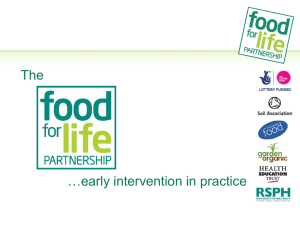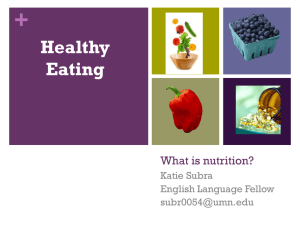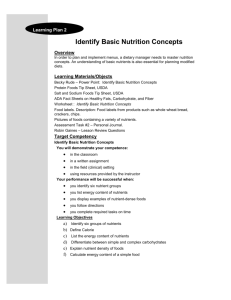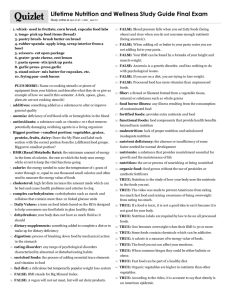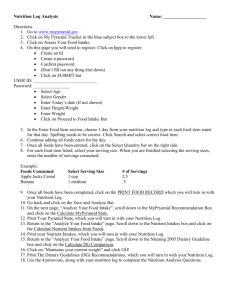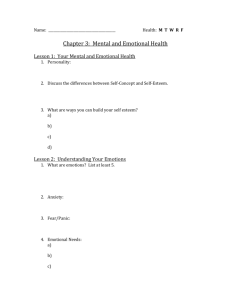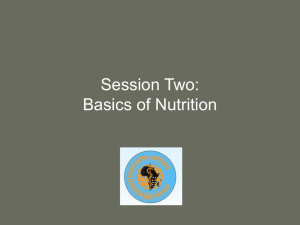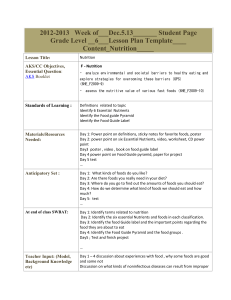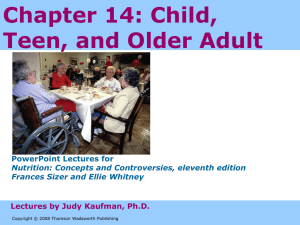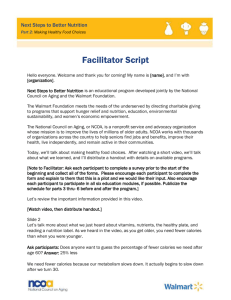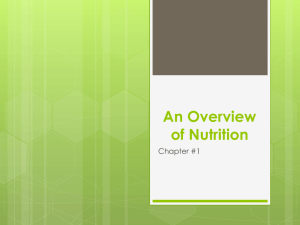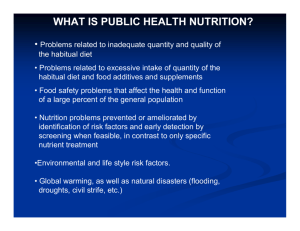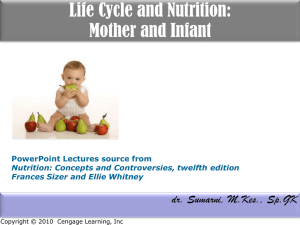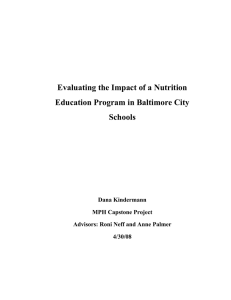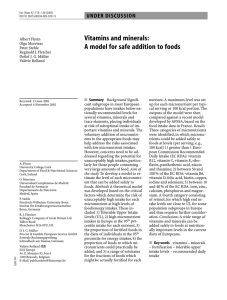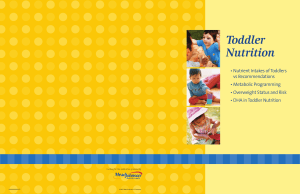Chapter 11 – The Life Cycle: Conception through the Later Years
advertisement
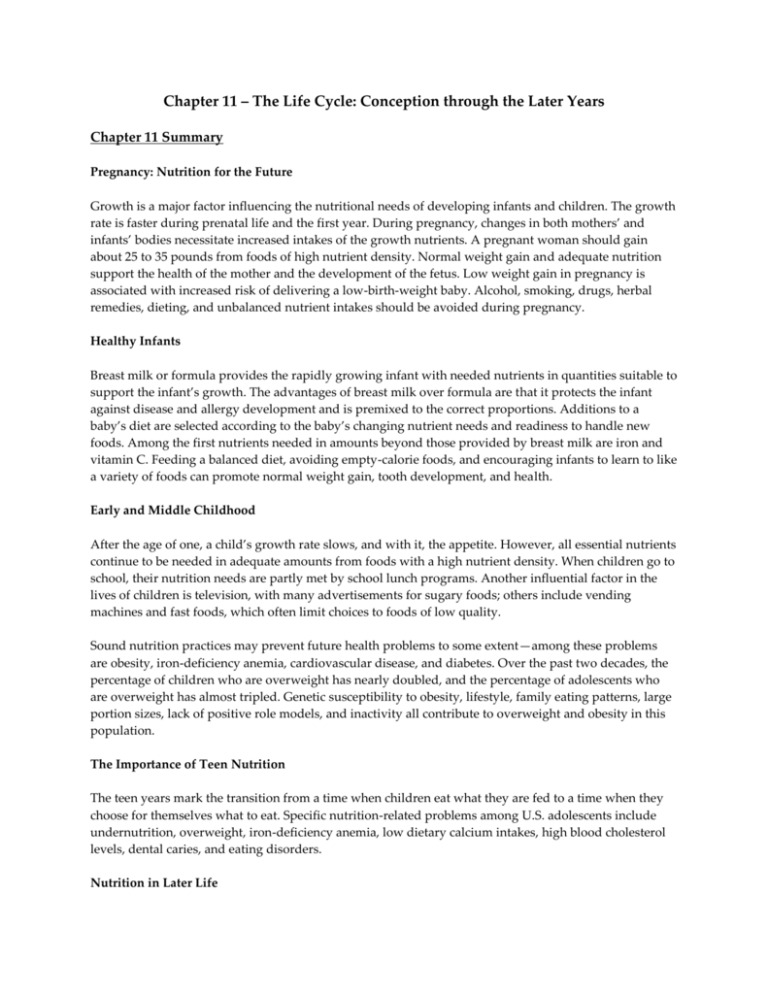
Chapter 11 – The Life Cycle: Conception through the Later Years Chapter 11 Summary Pregnancy: Nutrition for the Future Growth is a major factor influencing the nutritional needs of developing infants and children. The growth rate is faster during prenatal life and the first year. During pregnancy, changes in both mothers’ and infants’ bodies necessitate increased intakes of the growth nutrients. A pregnant woman should gain about 25 to 35 pounds from foods of high nutrient density. Normal weight gain and adequate nutrition support the health of the mother and the development of the fetus. Low weight gain in pregnancy is associated with increased risk of delivering a low-birth-weight baby. Alcohol, smoking, drugs, herbal remedies, dieting, and unbalanced nutrient intakes should be avoided during pregnancy. Healthy Infants Breast milk or formula provides the rapidly growing infant with needed nutrients in quantities suitable to support the infant’s growth. The advantages of breast milk over formula are that it protects the infant against disease and allergy development and is premixed to the correct proportions. Additions to a baby’s diet are selected according to the baby’s changing nutrient needs and readiness to handle new foods. Among the first nutrients needed in amounts beyond those provided by breast milk are iron and vitamin C. Feeding a balanced diet, avoiding empty-calorie foods, and encouraging infants to learn to like a variety of foods can promote normal weight gain, tooth development, and health. Early and Middle Childhood After the age of one, a child’s growth rate slows, and with it, the appetite. However, all essential nutrients continue to be needed in adequate amounts from foods with a high nutrient density. When children go to school, their nutrition needs are partly met by school lunch programs. Another influential factor in the lives of children is television, with many advertisements for sugary foods; others include vending machines and fast foods, which often limit choices to foods of low quality. Sound nutrition practices may prevent future health problems to some extent—among these problems are obesity, iron-deficiency anemia, cardiovascular disease, and diabetes. Over the past two decades, the percentage of children who are overweight has nearly doubled, and the percentage of adolescents who are overweight has almost tripled. Genetic susceptibility to obesity, lifestyle, family eating patterns, large portion sizes, lack of positive role models, and inactivity all contribute to overweight and obesity in this population. The Importance of Teen Nutrition The teen years mark the transition from a time when children eat what they are fed to a time when they choose for themselves what to eat. Specific nutrition-related problems among U.S. adolescents include undernutrition, overweight, iron-deficiency anemia, low dietary calcium intakes, high blood cholesterol levels, dental caries, and eating disorders. Nutrition in Later Life Aging is an inevitable, natural process programmed into our genes at conception. Many of the changes are inevitable, but a healthful lifestyle that combines regular physical activity with adequate intakes of all essential nutrients can forestall degeneration and improve the quality of life into the later years. Although caloric needs may decrease with age, the need for certain nutrients such as calcium, vitamin D, vitamin C, vitamin B12, and vitamin B6 may actually increase with the effects of aging. A new, narrower food guide pyramid for adults over age 70 shows a recommended eating pattern that reflects the lower caloric needs of most healthy older adults and emphasizes the need for adequate fluid intake. The enjoyment of food is enhanced if loneliness—a major problem of older people living alone—can be alleviated. Eating with others often restores the appetite and health that may seem to be failing due to degenerative disease. As a person gets older, the chances of suffering a chronic illness or disability become greater. Individually or in combination, the social, economic, psychological, cultural, and environmental factors associated with aging may interact with the physiological changes and further affect nutrition status in older adults. Assessment tools from the Nutrition Screening Initiative help individuals identify and score factors placing them at nutritional risk. Old age need not be a time of despair, isolation, and ill health. Preparation for enjoyable later years should include financial planning, the establishment of lasting social contacts, the learning of skills and activities that can be pursued into later life, the maintenance of a program of regular physical activity, and the cultivation of healthy nutrition status throughout life. Looking Ahead and Growing Old Adults should prepare financially, socially and health-wise for the future, so that they can reach old age with a healthy mind and body. Avoiding social isolation is especially important. Addressing Childhood Obesity A growing population of overweight children in the U.S. is developing chronic diseases such as type 2 diabetes, CVD, and gallbladder disease. Social trends, including fast food dining and sedentary activities for children, have contributed to overweight in children. Modeling for and teaching healthy eating and exercise habits to children can help them to grow without excessive weight gain, and maintain a healthy body composition later in life.
